Introduction: Pikey Peak Trek
The Pikey Peak Trek is a unique destination located in the Himalayan region of Nepal, where visitors can have the opportunity to view the world's highest mountain, Mount Everest. The Pikey comes as a mountain peak located on an altitude of 4,067 meters in the region of Everest. It is one of the prominent mountains of the Solukhumbu district of Nepal. The Pike Peak trekking trail is reportedly a newly introduced trekking route in the Everest region, offering an opportunity to escape the crowds and immerse oneself in a comfortable and peaceful trekking atmosphere.
Additionally, the Pike Hill trek not only provides an isolated trekking experience but also offers fellow trekkers magnificent mountain views, including Mt. Everest, Mt. Lhotse, Mt. Numbur, Mt. Gaurishankar, Mt. Kanchenjunga, Mt. Makalu, and others. Likewise, the viewpoint from Pikey Peak is mesmerizing and renowned for its incredible sunrise and sunset views. Even according to legend, Sir Edmund Hillary considered Pikey Peak his favorite vantage point for viewing the beauty of Mount Everest and witnessing the perfect sunrise and sunset. The 360-degree mountain view from the Summit is something to appreciate from the Pikey peak.
On the other hand, Pikey Peak is derived from the two titles of the deity of the Sherpa and Tamang communities, which is also known as Pikey Lhachu or Pikey Hlapchen Karbu. The locals of the Solukhumbu region host a festival every July to worship this deity, who is believed to control the weather.
Now, the Pikey Hill trek is an excellent addition to the Everest trekking region for those who wish to witness the breathtaking panoramic views of snow-capped mountains. Likewise, the Pikey Peak Trekking Route is relatively easy and suitable for all age groups interested in trekking. The trek is doable throughout the year; however, the best experience is during spring and Autumn, when the weather is moderate and the surrounding area is warm, providing a comfortable walking experience. Similarly, most of the trekking route to Pikey Peak is filled with traditional villages that offer the opportunity to immerse oneself in the culture, tradition, and festivals, giving insight into the Himalayan lifestyle.
The trek to Pikey Peak includes serene walks through forested areas, where you can view exotic flora and fauna. Trekkers can see a landscape filled with pink and red rhododendrons, cascading waterfalls, free-flowing rivers, a layered hilly terrain, and towering snow-capped peaks that lead towards the Pikey Peak Summit. Trekkers can also observe the significant influence of Buddhism and Hinduism along the route. Chortens, mani walls, prayer wheels, temples, prayer flags, monasteries, and other highlights are visible throughout the area.
One of the main highlights of the Pikey Peak area is a visit to the Thupten Choling Monastery, a historic Buddhist monastery in the region. The Monastery is located in Junbesi along the Pikey Peak Trekking Itinerary. Kyabje Trulshik Rinpoche established the Monastery in the 1960s, and it has since evolved into a community retreat that welcomes individuals from all around the world to experience the rich culture and traditions of the Everest Region.
How does the Pike Hill Trek start and end?
The first half of the Pikey Peak trek involves a drive to the beautiful village of Dhap Bazaar. Then, from the Dhap Bazaar, the ultimate trekking journey starts where trekkers will pass through numerous traditional villages and ultimately reach the Summit of Pikey Peak.
The Drive from Kathmandu to Dhap Bazaar.
The Pikey Peak trek begins with arrival in the bustling capital city of Nepal, Kathmandu. Then, from Kathmandu, a drive on a private or public vehicle leads to Dhap Bazaar, the first destination on the Pikey Peak Trekking route. The private vehicle is comparatively more expensive than the public one; however, driving privately allows for a more comfortable and convenient journey. However, the choice of vehicle is entirely based on personal interest.
The Drive from Kathmandu to Dhap Bazaar follows the Sun Koshi River. During the drive, passengers can sense the transition from the busy urban area to the more remote or rural regions of Nepal. Initially, the drive is mostly on black-topped roads, which are mostly alongside the river. Then, slowly, passengers can feel the shift to the rural side, where some sections have bumpy roads and off-road areas due to ongoing construction projects. So, trekkers will reach Dhap Bazaar, observing traditional villages, terraced fields, waterfalls, rivers, and mountains along the way.
Trekking trail to Pikey Peak
After the brief stop in Dhap Bazaar, the road trip comes to an end, marking the beginning of the trekking journey. So, from Dhap Bazaar, the official trek to Pikey Peak begins, where guides will provide direction and porters will carry all the luggage. Then, with a mesmerizing and cheerful emotion, the journey to Pikey Peak begins, heading towards the first overnight stop at Jhapre. Jhapre is home to small Buddhist monasteries and stupas, offering a clear view of the surrounding mountains, including the Numbur Himal. Jhapre, being a traditional village, also consists of terraced farmlands, some livestock, and is thoroughly established in a conventional setting.
After a quality time in Jhapre, the trek moves towards Pikey Peak Base Camp via Bulbule. One can enjoy a 360-degree panoramic view from the Pikey Hill Base Camp. Similarly, the base camp is also a notable place for a mesmerizing sunrise and sunset view.
Then, moving along from the Pikey Peak Base Camp, the next destination is the Pikey Peak Summit, which is the ultimate goal of the entire trip. Trekkers can enjoy the quality time in the Summit and witness the panoramic view. Similarly, trekkers can also click pictures and celebrate the success of the Summit. Afterwards, trekkers can start the return journey from the Summit to Jasmane Bhanjyang. Trekkers can reach Jasmane Bhanjyang by following the ridge line of Pikey Peak and then continuing towards Junbesi for an overnight stay.
Junbesi is another beautiful settlement in the Pikey Peak region, which is named after the moon. The Junbesi village is located alongside Junbesi Monastery and Ngagyur Sergon Lungrig Sedrup Zungdelling Monastery. The area is also decorated with prayer flags and prayer wheels.
Trekkers will also spend an additional day in Jasmane Bhanjyang for rest and acclimatization. During the rest day, trekkers will visit the Thupten Choling Monastery (one of the biggest monasteries of the region) located on the lap of Numbur range, and trekkers will also see another vantage point for the view of Mount Everest. Similarly, trekkers will also have the opportunity to acclimate to the lower oxygen levels that persist at higher altitudes, reducing the risks of altitude sickness..
Then, from Junbesi, trekkers will move to Phaplu via a narrow road, followed by a flat section. After reaching Phaplu, trekkers will conclude their trekking journey and board a vehicle to return to Kathmandu. When the drive is completed, the Pikey Peak Trek with Nepal Trekking Planner comes to an end.
Pikey Hill Trekking: 10 Days Altitude and Distance Coverage
Day | Activity | Altitude (m/ft) | Distance (km/miles) | Duration (hours) | Elevation Gain/Loss |
01 | Arrival in Kathmandu and transfer to the hotel. | 1,350 m / 4,430 ft | - | ~30 min drive | - |
02 | Drive from Kathmandu to Dhap Bazaar. | 2,850 m / 9,350 ft | ~260 km / 161 miles (via Okhaldhunga) | ~8-9 hrs drive | +1,500 m / +4,921 ft |
03 | Trek from Dhap Bazaar to Jhapre. | 2,815 m / 9,236 ft | ~12 km / 7.5 miles | ~4-5 hrs walk | -35 m / -115 ft |
04 | Trek from Jhapre to Pikey Base Camp. | 3,640 m / 11,942 ft | ~13 km / 8 miles | ~5-6 hrs walk | +825 m / +2,707 ft |
05 | Trek to Jase Bhanjyang via Pikey Peak Summit. | 4,065 m / 13,336 ft | ~15 km / 9.3 miles | ~6-7 hrs walk | +425 m / +1,394 ft |
06 | Trek from Jase Bhanjyang to Junbesi. | 2,700 m / 8,858 ft | ~12 km / 7.5 miles | ~5-6 hrs walk | +20 m / +65 ft |
07 | Visit Thupten Chyoling Monastery or Go To another Everest View Point | 3000 m/ 9,842 ft | ~2.5 km / 1.5 miles | ~1 hour walk | +300 m / +985 ft |
08 | Trek from Junbesi to Phaplu. | 2,460 m / 8,071 ft | ~10 km / 6.2 miles | ~4-5 hrs walk | -240 m / -787 ft |
09 | Drive from Phaplu to Kathmandu | 1,350 m / 4,430 ft | ~250 km / 155 miles | ~8-9 hrs drive | -1,110 m / -3,641 ft |
10 | Final Departure | - | - | - | - |
Best Time for Pikey Peak Trekking
The best time to trek in Nepal is throughout the year. However, due to the varied weather patterns, every season provides a unique experience. For the Everest region trekking, Spring and Autumn are the best times, as they provide moderate weather conditions without complications, ultimately favoring comfortable walking conditions. However, people can trek towards Pikey Peak during both winter and summer. However, the weather conditions are not recommended for beginners and are suitable only for hardcore trekkers. Here is a brief overview of the trekking seasons for Pikey Hill.
Pikey Hill Trek in Spring (March to May)
Spring in Nepal lasts from March to May, which is one of the best seasons for Pikey Hill Trekking. The spring season in Pikey Hill is marked by the full bloom of rhododendrons, which paint the landscape with shades of red and pink. Likewise, the skies are clear, which provides an unobstructed view of the snow-capped mountains. The atmosphere is neither too hot nor too cold, which gives the perfect environment for walking. The average temperature on Pike Peak during spring is 10-20 degrees Celsius.
On the other hand, the greenery and vibrant colors provide additional motivation for the trek. However, as spring is one of the best seasons, trekkers should expect some crowds on the trekking trail. Similarly, it is advisable to book in advance, as the number of accommodation options may be filled during these periods.
Pikey Hill Trek in Autumn (September to November)
Autumn in Nepal lasts from September to November, which is considered the most popular trekking season in the country. The Himalayan landscape is painted in shades of grey, yellow, green, and crimson, while notable trees shed their leaves, leaving a unique experience. Similarly, the autumn season offers moderate climatic conditions, providing a comfortable environment for walking and exploration. There is very little to no rainfall, so the stable climatic condition with clear skies also provides an unobstructed mountain view. The sunrise and sunset views are also breathtaking, with the sun's rays casting a glow along the snow-capped mountains.
On the other hand, the autumn season in Nepal is a time of festivities. The grand festivals of Nepal, Dashain, Tihar, Chhath, and Mani Rimdu all fall during the autumn season. So, it is the perfect opportunity to experience the culture and traditions and immerse oneself in the festive atmosphere. In the mountains, trekkers can witness unique and exciting celebrations, masked dances, and other cultural activities. The average temperature of the Pikey Peak region in Autumn ranges from 9 to 17 degrees Celsius.
Pikey Hill Trek in Monsoon/Summer (June to August)
The summer season in Nepal coincides with the monsoon season, which lasts from June to August. The monsoon season is considered one of the off-seasons for trekking in Nepal, where trekking activities are minimal on most trekking routes available in the country. The main reason to consider summer as an off-season is due to heavy rainfall that causes severe difficulties in high altitudes.In the same way the hazy sky during the monsoon comes in the way of the view of the mountains as well, which makes trekking a low value affair. There are also risks of landslides and flooding that make the adventure more challenging, especially for beginner trekkers. There is also a possibility of leeches and slippery trails, making the experience more extreme. The summer temperature in the Pikey peak region lasts at an average of 15 to 25 degrees Celsius.
Pikey Hill Trek in Winter (December to February)
The winter season in Nepal lasts from December to February, marking another off-season period for trekking in the country. Extreme cold weather conditions and snowfall mark the winter season. The Pikey Peak Trails are covered by snow and ice, making the trekking routes slippery and dangerous. Likewise, the trails at higher altitudes are often covered with thick snow, which can cause difficulty in navigation, especially when traveling solo. Similarly, cold conditions require thick clothes and additional preparation, which increases the luggage weight, making it challenging to move flexibly.
It is not impossible to trek to Pikey Peak in Winter, although it requires additional preparation; the trip can still be completed. Winter pikey peak trek is recommended chiefly for hardcore trekkers who have previous experience of trekking and want to go for something extreme. During the winter period, the crowds are minimal, and the views are excellent, making it an ideal time for those seeking an isolated experience. The average temperature in Pike Hill during winter is about 5 to 15 degrees Celsius. Still, it can drop to as low as -5 to -17 degrees Celsius.
Local Culture and Tradition in Pikey Peak Trek
The Pikey Peak is located in the everest region which is mainly occupied by the Sherpa community followed by other ethnic groups like the Tamang. The Sherpas are known to be extremely strong and have an immense experience of mountain climbing and that is why they have been the guide of choice when trekking or climbing in the mountains. Sherpa communities can be found in traditional settlements such as Dhap Bazaar, Jhapre, Jase Bhanjyang, Junbesi, and Phaplu.
Recommendation Read: People of the Himalayas
The Sherpa community primarily follows the Buddhist religion, which is reflected in the numerous monasteries, stupas, prayer flags, prayer wheels, and mani walls along the route. Trekkers can also encounter the occasional sculpture, shrine, temple, and gompa along the path, where morning prayers and worship are held. All these establishments have both spiritual and religious significance for the local people, and many expect a significant amount of respect from fellow travelers.
Similarly, monks and nuns dressed in orange or maroon robes are highly valued in such a society. It is recommended to bow your head as a sign of respect to such religious figures if encountered along the route. Be sure to leave them space to walk and not to touch them without permission.
On the other hand, the main festival of the Sherpa people is Mani Rimdu, which lasts for 19 days, symbolizing the introduction of Buddhism to Tibet by Guru Rinpoche, also known as Padmasambhava. The festival is hosted in Tengboche Monastery but is celebrated across the Everest region. Likewise, the festival features prayer sessions, masked dances, and cultural music, providing an additional layer of enjoyment and relaxation for trekkers.
Likewise, the Sherpa people are known for their hospitality. Trekkers can see the hospitable and welcoming nature of locals in the teahouse and other accommodation options. There is also a high regard for community togetherness, as Sherpas often love gatherings and celebrations.
Accommodation Options Available in Pikey Hill Trekking
There are several accommodation options available during the Pikey Hill Trek. The accommodation options range from basic teahouses to luxurious houses, depending on the altitude and location. Similarly, the budget for the overnight stay also relates to the choice of accommodation, where teahouses are the cheapest options and luxury houses are the most expensive ones. The available options for accommodation are mentioned below:
- Teahouses: The teahouses are the most affordable and basic accommodation option available during the Pike Hill Trek. The teahouses offer basic bed and blanket facilities, along with a selection of local food options available right from the menu. Likewise, as teahouses have limited choices, the bathroom and shower are often shared, located either in a flat or outside the building. There are also Wi-Fi and electricity, which are generally available for an additional cost. A single room in the teahouses contains one twin bed or two single beds. (Note: Recommendation read on blog "Tea House Trekking in Nepal")
- Lodges: The lodges available on the Pikey Peak trail are often more sophisticated than the local teahouses. The lodges offer larger and more luxurious rooms for an overnight stay and are mostly owned by residents. Comparatively, staying in lodges is more expensive than in teahouses; however, trekkers do receive a set of amenities, including an attached bathroom, hot shower, and Wi-Fi. Some lodges also have electric blankets and heaters for a cozy night in cold weather conditions. However, lodges are only available in some areas along the route. On the other hand, trekkers can enjoy fresh local dishes offered on the menu.
- Luxury houses: These are the most facilitated accommodation options available on the Pikey Peak hike. The luxury houses provide all possible amenities, including hot showers, electricity, Wi-Fi, heaters, attached bathrooms, and electric blankets, all within the cost of the room. The expense of a stayaway charges in high-end houses, however, may be too much to budget tourists. Likewise, such forms of choices are scarce and only present in bigger settlement areas.
Amenities Available During Pikey Peak Trekking
Electricity and Charging
Electricity is a crucial amenity for trekkers, especially for those who need to charge their electronic devices. Whether charging a cell phone, laptop, camera, or any other device that requires a power source, a stable electrical connection is necessary. Most of the charging is done in the accommodation options where trekkers choose to stay overnight. The charging ports in the accommodation options can also vary, so it is necessary to understand the types of charging ports used in Nepal or be sure to carry a universal port. Similarly, the accommodation options like teahouses can charge trekkers extra for electricity usage. If you are staying in teahouses, you may need to charge your device in the lobby by taking turns, especially if you are trekking during peak season.
You may also consider yourself lucky if you find a charging port inside your room. But in other accommodation options, there is no additional cost for charging, and a port is readily available inside the room. For budget travelers who wish to avoid the cost of charging, bringing an extra set of batteries and power banks allows you to charge your devices on the go.
Communication
Cellular communication can be essential for some trekkers who may not have access to the internet. However, if you are a first-time traveler in Nepal, you may not know where to purchase a Nepalese SIM card or be confused about the cost of a SIM card. To clear up any confusion, Trekking Planner Nepal provides a free Nepalese SIM card (NCELL) for use. With a few balances, you can communicate locally. Likewise, the provided SIM card will come with 20-30 GB of data that can last for 28 Days. However, the data will come with a minimum cost. Therefore, obtaining an NCELL SIM will enable trekkers to communicate, make phone calls, and access the internet during their stay in Nepal.
Internet and Wi-Fi
Internet and Wi-Fi are not well-developed in the mountains, so there may be some lag while using the internet along the Pikey Peak route. Wi-Fi facilities are only available in local cafes or accommodation options, which may incur an additional cost. Similarly, suppose you purchased a SIM card with data inserted. In that case, it may not work correctly while traveling through mountain passes or forest areas. However, relying on the SIM's internet is better than having a disrupted Wi-Fi connection.
Hot Shower
While the Pike Peak Itinerary is for 10-day trekkers, they can compromise on the shower if necessary. If not, the cold shower should be omitted, as it can cause problems in cold weather conditions. So, it is best recommended to rely on a hot shower. Hot showers are available in the accommodation options, although the availability may vary. In other words, the shower can be either a bucket or a tap, which mainly relies on solar energy. For budget travelers, hot showers can be an additional cost, so it's better to carry napkins, wet wipes, or dry shampoo to stay fresh without relying on paid facilities.
Toilet and Toiletries
Most of the toilets in Pikey Peak are pit latrines. Still, there is also availability of European-style toilets in more sophisticated accommodation options. Likewise, toilets during the lunch stop are also pit latrines, which trekkers need to compromise with. In basic options like Teahouses, the toilets may be far from the main building or often shared. Likewise, there may or may not be availability of toiletries like napkins and tissue paper inside the restroom. Therefore, it is recommended to carry your toiletries to be prepared for such situations.
Food and Beverage Options on the Pikey Peak Trek
Food and water are the source of energy during the trek. Therefore, it is essential to replenish yourself by eating enough food and drinking water after a tiring, long walk. During the Pikey Peak Trek, a variety of foods are offered on the menu for breakfast, lunch, and dinner, ranging from local Nepalese dishes to continental, Indian, and Italian options. While European foods are also available, it is recommended to try Nepalese cuisine, which is freshly made and seasonal. The food options available for breakfast, lunch, and dinner are as follows:
- Breakfast: Pancakes, eggs, Bread, Porridge, Toasted bread, Chapati, Muesli, potato items, Soups, Mixed vegetables, Biscuits, Cookies, and many more.
- Lunch: Papad, Pizza, Sandwich, Mo: Mo, Popcorn, Vegetable and salad, Prawn and Crackers, Pasta, Varieties of soup, Chips, Noodles, Dal Bhat, Thukpa, Chowmein, French fries, and many more.
- Dinner: Dinner options are similar to those at lunch, where individuals can order anything from the menu. The most popular dinner option in Nepal is Dal Bhat (rice with lentil soup), and it is readily available throughout the trekking route.
- Drinks and Beverages: Black tea, Milk Tea, Coffee, Hot water, Green tea, Ginger lemon tea, Masala tea, Lemon tea, Mint tea, Hot chocolate, Milk Coffee, and many others.
- Desserts: Apple Pie, Pancakes with Honey, Rice Pudding, Snickers or Mars Pie, Yogurts with Fruits, Apple Pie with Custard, Chocolate Pudding, Pastries, and others.
How to Prepare for Pikey Peak Trekking in Nepal?
Understanding the Trek
Trekkers should have thorough background research about the Pikey Peak trek. The altitude, trekking duration, and difficulty are all factors that all trekkers should consider. Similarly, trekking enthusiasts for Pikey Peak must decide whether the trek is right for them, as sometimes the expectations may not match the reality.
Physical Preparation
All trekkers should be physically fit for the trek. Although the pikey peak trek is labelled as a moderately challenging trek, altitude and Nepalese terrain can be a problem for beginner trekkers. It is recommended to start training at least 4-6 weeks before the trek. However, hardcore training that includes weight lifting is not necessary. Trekkers should focus on cardiovascular training that includes activities such as hiking, jogging, cycling, running, and swimming. Similarly, it is better to focus on strength training like leg squats, planks, lunges, and push-ups. During cardio training, practice with a backpack on uneven terrain that can simulate trekking conditions.
Understanding the Best Time to Trek
If you are a beginner trekker, consider doing the Pikey Peak Trek during the Spring and Autumn Seasons, which are considered the best times. However, suppose you are more experienced and are not bothered by extreme weather conditions. In that case, you can trek during summer and winter. However, be aware that the best time to trek is when you are both mentally and physically ready to take on the trekking route.
Acclimatization
Altitude is a primary concern for the Pikey Peak Trek. The highest altitude trekkers will reach during the trek is 4,067 meters. Such altitude can pose a threat of altitude sickness, so these risks need to be minimized. One way to do this is through acclimatization. Acclimatization is a process of adjusting the body to low oxygen levels that persist at high altitudes. Your trekking itinerary includes acclimatization or rest days, during which you are required to participate in day hikes that help counteract the effects of altitude sickness.
Proper Packing
Trekkers should have a proper planning process, where they should pack light yet smart. All individuals planning for the trek should pack all the necessary items that ensure comfort, safety, and efficiency during the trek. The trail above 4000 meters can be chilly, while the lower altitudes may be sunny during the day but freezing at night. So, it's essential to pack proper layers, including moisture-wicking base layers, insulating down jackets, and a waterproof outer layer. Similarly, all trekkers should pack essentials like comfortable trekking pants or shorts, sturdy boots, warm gloves, a hat, and a buff to protect against the cold.
On the other hand, trekkers are recommended to carry a small daypack that holds daily essentials, such as water bottles, snacks, sunscreen, sunglasses, toiletries, a headlamp, and a first aid kit. With all that in mind, every individual trekker should master the art of proper packing. One should not overpack and be a burden to the Sherpas, nor should one underpack, as the most crucial items for the trek can go missing.
What are the Permits Required for the Pikey Peak Trek?
The Pikey Peak Base Camp is located within the Sagarmatha National Park region, which is designated as a restricted area by the Government of Nepal. To pass through such restricted areas, all trekkers must obtain permits authorized by both the local body and the government. Thus, several documents have been issued, acting as the Pikey Peak Trekking Permit, which will allow trekkers to explore the restricted area. Such permits are mentioned below:
- Sagarmatha National Park entry permit: NPR 3,000 (around USD 30) per person.
- Gaurishankar Conservation Area Permit (GCAP): NPR 3,000 (about USD 30) per person.
- Local Area Permit: NPR 2,000 (around USD 17) per person.
Is Travel Insurance Required for Pikey Peak Trekking?
Although it is not mandatory, purchasing travel insurance can help to compensate against any unforeseen circumstances in the mountains. As we know, mountains can be unpredictable, and anything can happen; therefore, it is advisable to be insured. Trekking Planner Nepal doesn't provide insurance facilities; however, trekkers can have travel insurance from an authorized insurance company. But there are a variety of policies an insurance company can offer, so trekkers need to buy policies that can cover the following things:
- Trip Cancellation and Interruption
- Medical Emergency Coverage
- Emergency Evacuation and Rescue
- Theft or Loss of Baggage and Belongings
- Personal Injury and Property Damage
Outline Itinerary
Day 1: Arrival in Kathmandu (1400m)
Day 2: Drive from Kathmandu (1400m) to Dhap Bazaar (2850m)
Day 3: Trek from Dhap Bazaar (2850m) to Jhapre (2820m)
Day 4: Trek from Jhapre (2820m) to Pikey Peak Base Camp (3640m)
Day 5: Trek from Pikey Peak Base Camp (3640m) to the Summit (4065m), then descend to Jasmane Bhanjyang (3549m)
Day 6: Trek from Jasmane Bhanjyang (3549m) to Junbesi (2700m)
Day 7: Rest Day to Visit Thupten Chyoling Monastery or Go To another Everest View Point
Day 8: Trek from Junbesi (2700m) to Phaplu (2469m)
Day 9: Drive back to Kathmandu from Phaplu (2469m)
Day 10: Final Departure or onward to the next destination

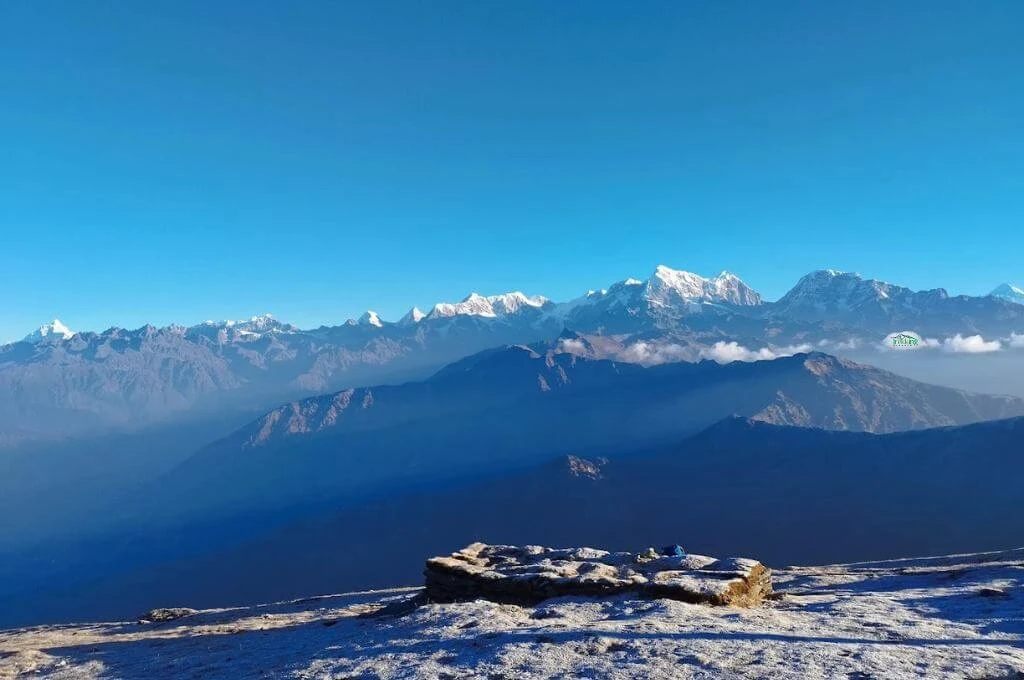
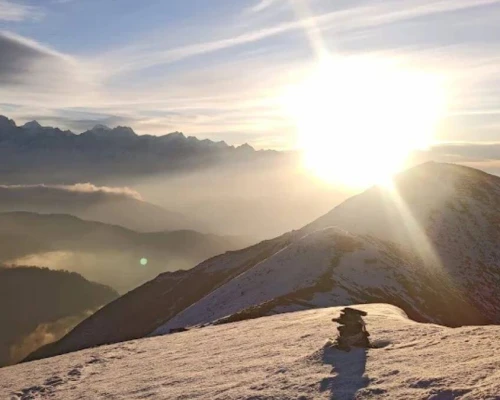
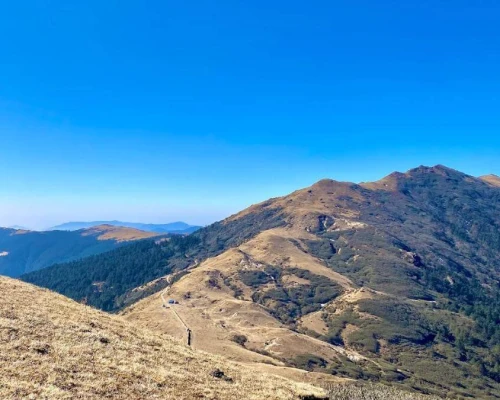
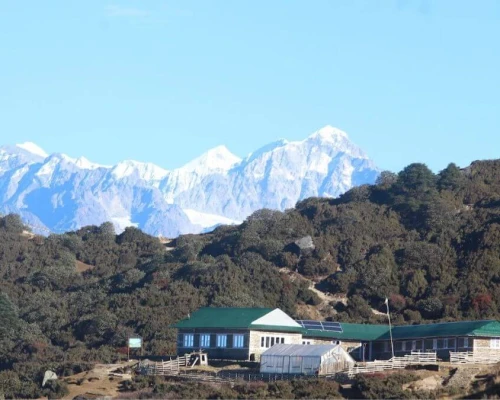
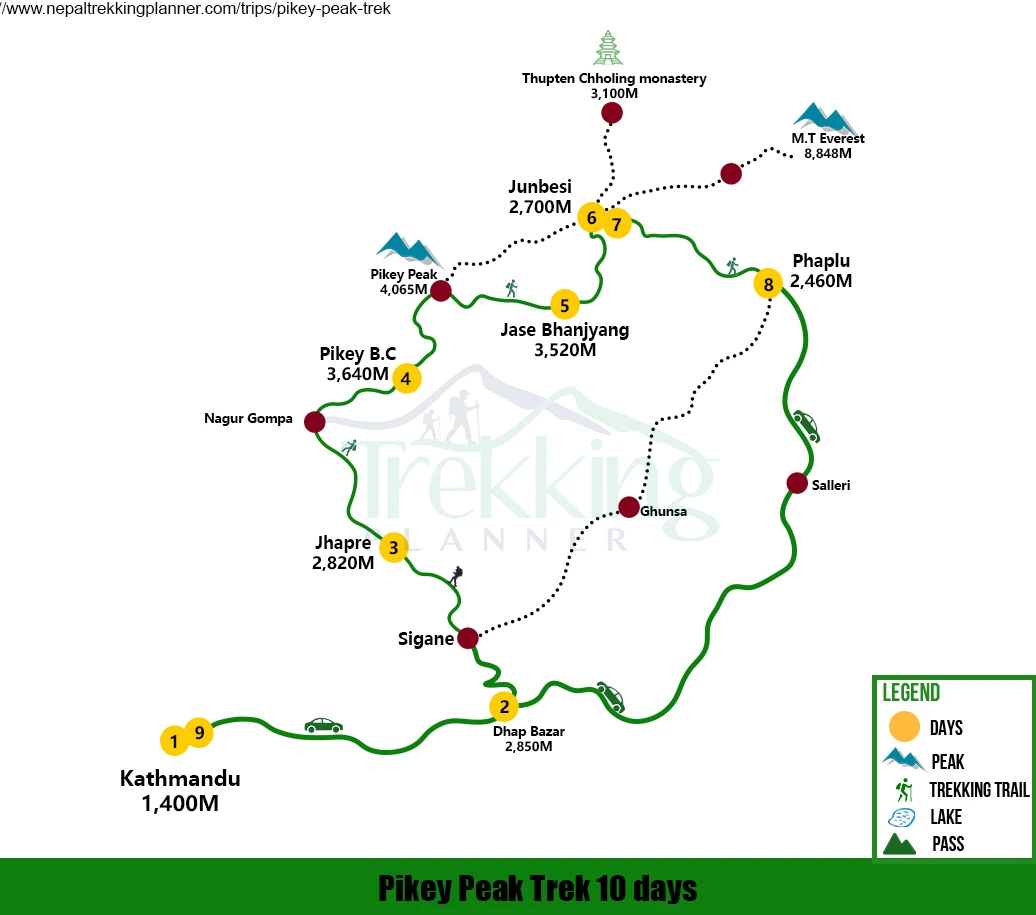
 General
General Upper Body
Upper Body Lower Body
Lower Body Other Essentials
Other Essentials



